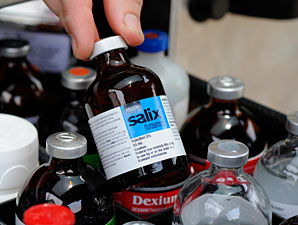Jockey Club Urging Potential Salix Study

The Jockey Club has called on leading industry organizations to come together to conduct a Salix study that would examine the timing of administration on the medication used to prevent exercise-induced pulmonary hemorrhage.
At the June 17 meeting of the Kentucky Equine Drug Research Council, member A. Gary Lavin, D.V.M., suggested a study examining the efficacy of Salix (furosemide, commonly called Lasix) at varied administration times. Currently Salix is the only race-day medication allowed in U.S. racing and it typically is administered four hours before competition.
The KEDRC advises the Kentucky Horse Racing Commission on medication policies and awards money for funding of medication studies.
Jockey Club executive director Matt Iuliano attended the meeting to offer support of the study and called on industry leaders to come together to fund and shape it. A veterinarian, Lavin represents breeders on the KEDRC and is a Jockey Club member.
"We thought it was pretty intriguing," Iuliano said of looking at the timing of Salix administration. "We thought it was a novel approach, something unique and new, and something that had not really been done before."
Iuliano said Lavin had talked about the study six or eight weeks ago. The idea was presented to the Jockey Club Thoroughbred Safety Committee, which approved Iuliano's attendance at the KEDRC meeting to support moving forward with other industry groups on such an examination.
Andy Roberts, D.V.M., represents the Kentucky Harness Horsemen's Association on the KEDRC. Roberts said he and Rick Hiles, who represents horsemen on the KEDRC, were blind-sided by the proposal.
Roberts said coming into the meeting, he and Hiles thought there was going to be discussion of replicating in the U.S. a well-known Salix study conducted in 2007 South Africa, "Efficacy of furosemide for prevention of exercise-induced pulmonary hemorrhage in Thoroughbred racehorses." The report determined the diuretic prevented or reduced the severity of EIPH in racehorses.
Roberts and Hiles, who both voted against the proposal of moving forward to shape the study, said they were not prepared to consider an examination on the timing of when Salix is administered.
"We got there and they used a bait and switch tactic," Roberts said. "We don't ever vote on stuff that's not in the packet. On that basis alone, I felt like they shouldn't have taken a vote."
Iuliano said in its research, The Jockey Club could find no previous study that looked at the effects of varying the administration time of Salix. He said The Jockey Club would like to see the KEDRC come back with a formal research proposal and budget recommendation. He said a group of industry experts from different backgrounds could be formed to help shape the study.
Iuliano said that the study could look at the effects of administering Salix 24 hours out or more but also 12 hours out, six hours out, or even two hours out.
Roberts noted that typically the KEDRC makes decisions on projects that already have well-defined outlines on how the study will be conducted. He said The Jockey Club's involvement would be a concern because of its opposition to race-day medication.
"The other thing is it's very clear that when The Jockey Club brings this to the table, that is a ridiculously thinly veiled attempt to get rid of Lasix," Roberts said. "That's all it is. There is no scientific reason to give a horse Lasix 24 hours out, none."
While the Jockey Club has opposed race-day medication, Iuliano noted that it has supported the National Uniform Medication Program, which allows Salix if it's administered by veterinarians designated by the local regulatory authority. Iuliano said The Jockey Club supports crafting the study because of curiosity about the question of varying timing of Salix administration.
"It's driven by a desire to understand," Iuliano said. "If that study, just like any other science that comes out, if that study indicates a certain regulatory action needs to be made, so be it.
"We would anticipate eagerly what this study would show. It could show that the current regimen should be maintained, or it could say administration time should be shorter or longer. But we're not going to know until we study it."
